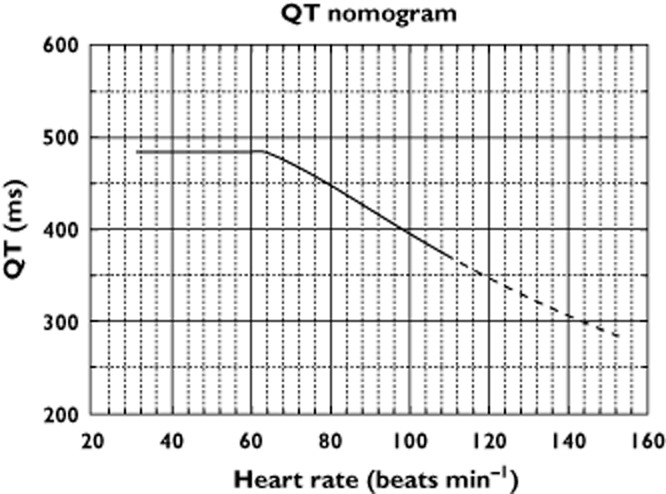Long QT syndrome (LQTS)
Background
- Prolonged ventricular re-polarisation = prolongation of the QT interval
- Risk of Torsade de pointes and sudden death
- Congenital or acquired
Acquired
Congenital
- Romano-Ward syndrome - autosomal dominant
- Lange-Nielsen syndrome - autosomal recessive (assoc. congenital deafness)
- F > M, usually childhood or adolescence
- Once identified, 1st degree relatives should be screened
| |
Normal QTc |
Prolonged QTc |
| Males or females <15 years old |
<0.44 s |
>0.46 s |
| Males > 15 years |
<0.43 s |
>0.45 s |
| Females > 15 years |
<0.45 s |
>0.46 s |

 QT nomogram (Chan et. al.). HR-QT pairs above the line = ↑ risk of TdP.
QT nomogram (Chan et. al.). HR-QT pairs above the line = ↑ risk of TdP.
Clinical Presentation
- Palpitations, syncope/near syncope, seizure, cardiac arrest
ECG findings
- QTc = QT/R-R-2. >0.45 sec abnormal
- Abnormal T-wave (notched or biphasic)
- T-wave alternans
Treatment
- "lifestyle modifications," (avoidance competitive sports and of all drugs known to prolong QT interval) (list)
- Treat with β-blockers (shorten the QT interval, reduce risk of Torsade and sudden death)
- High risk patients - implantable cardioverter-defibrillators (ICDs)
- Left cervicothoracic sympathectomy (block sympathetic to heart so reduce event rate)
Content by Dr Íomhar O' Sullivan. Last review Dr ÍOS
27/09/21
.

